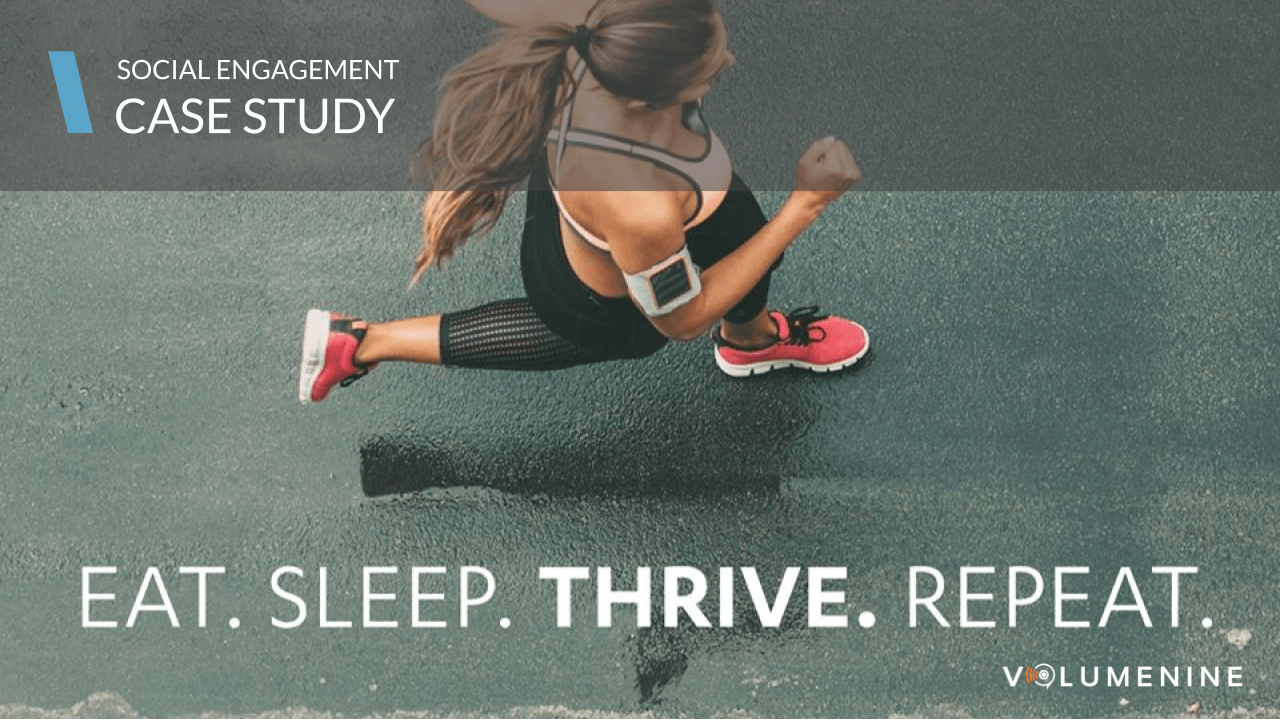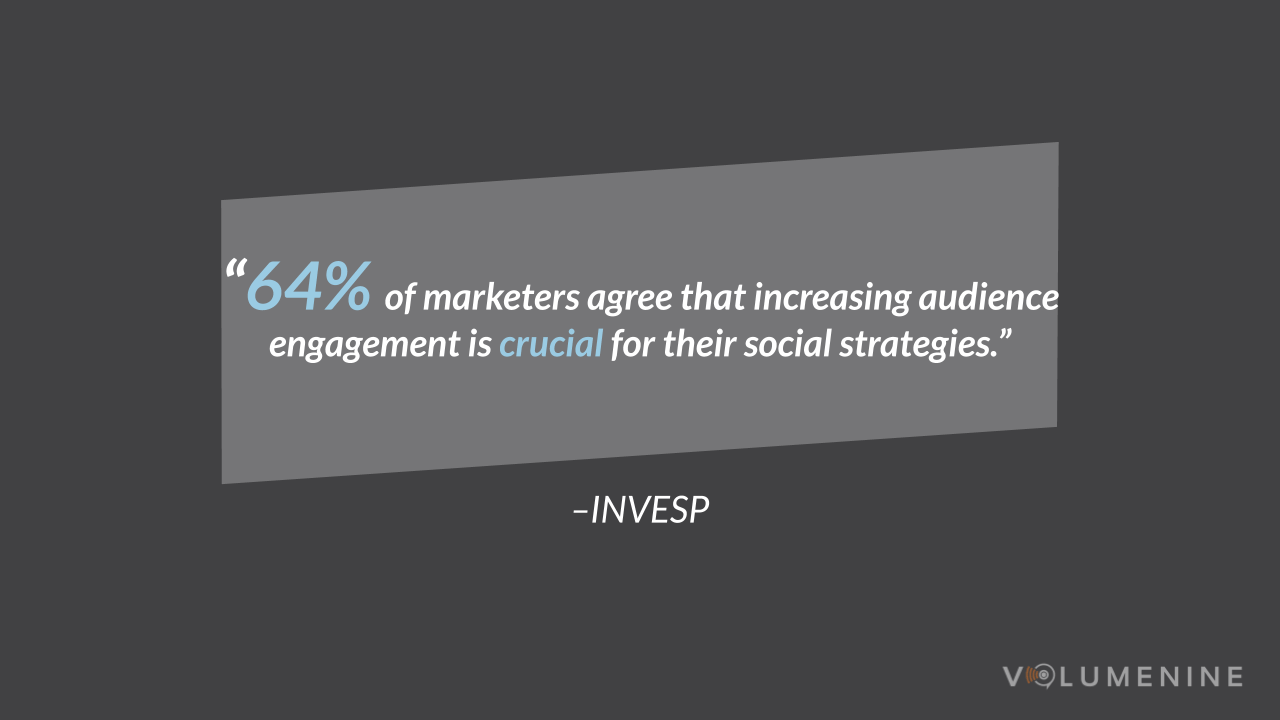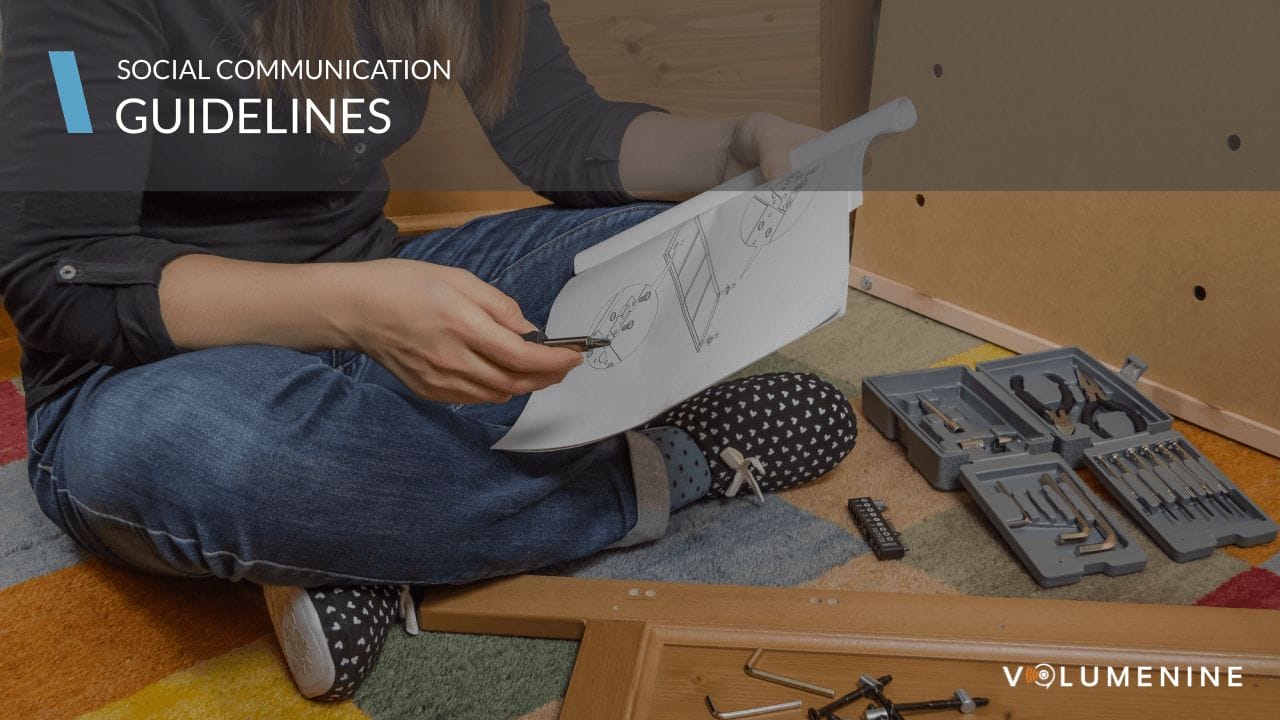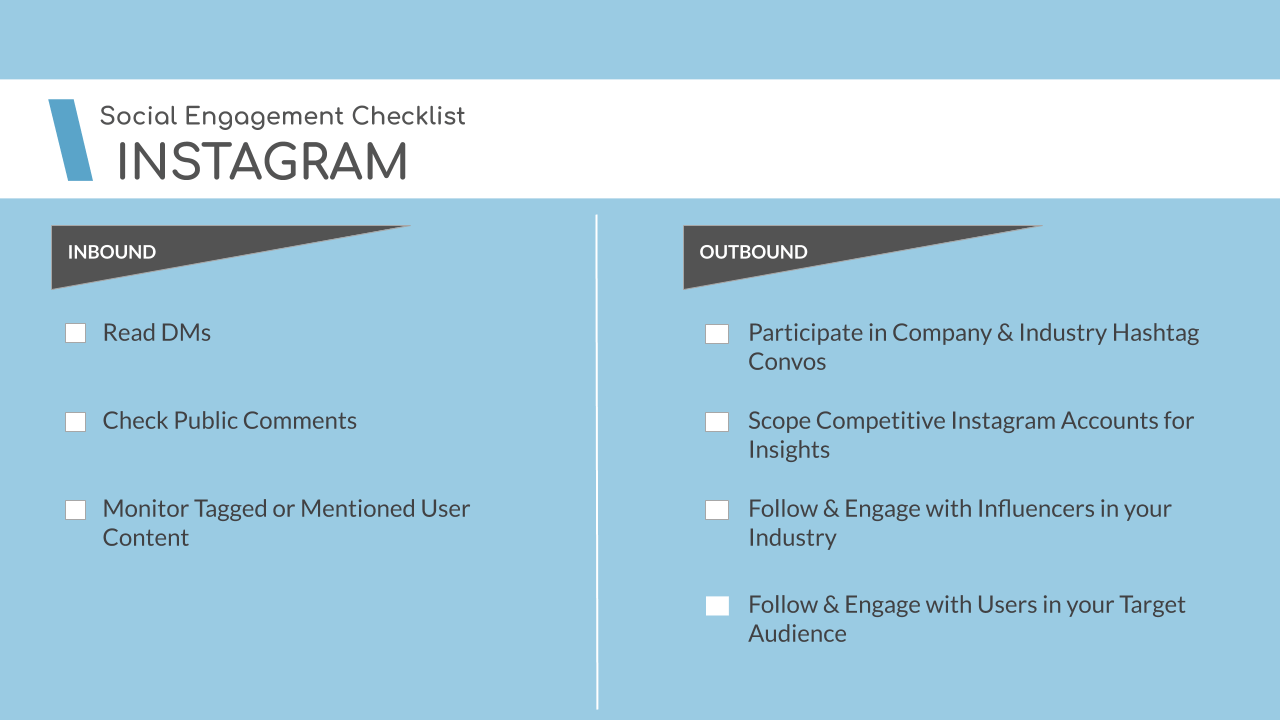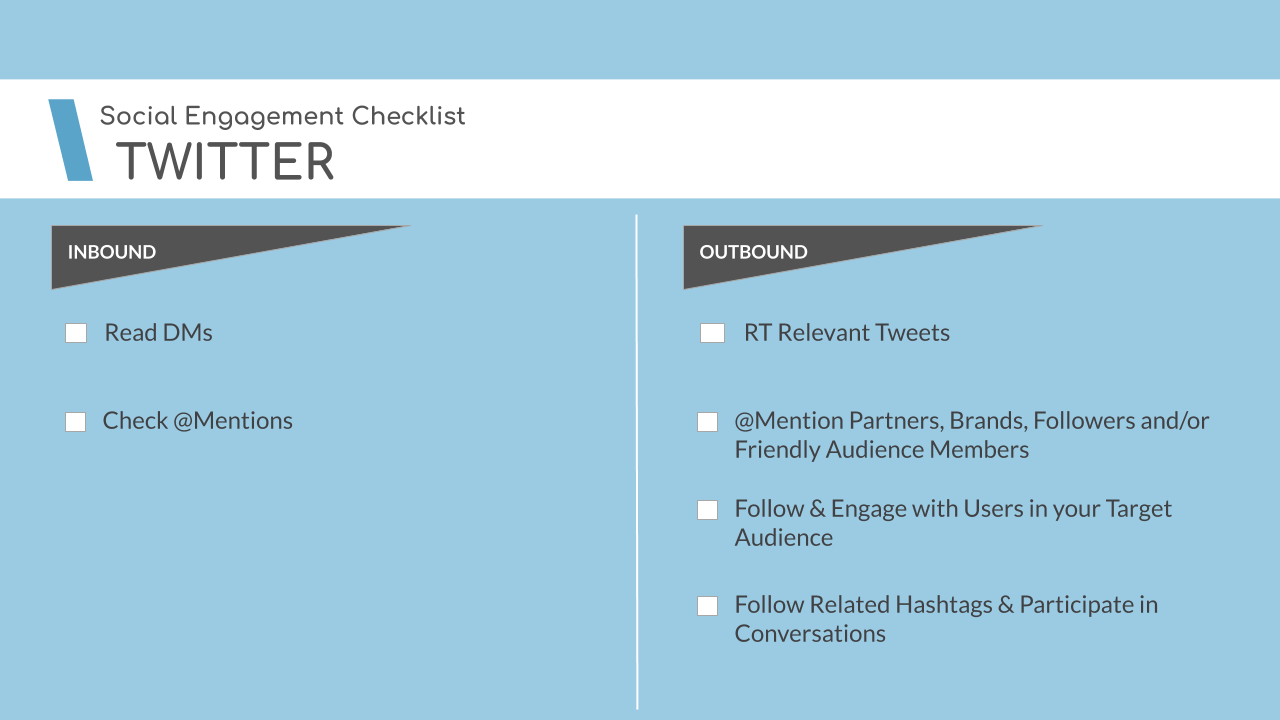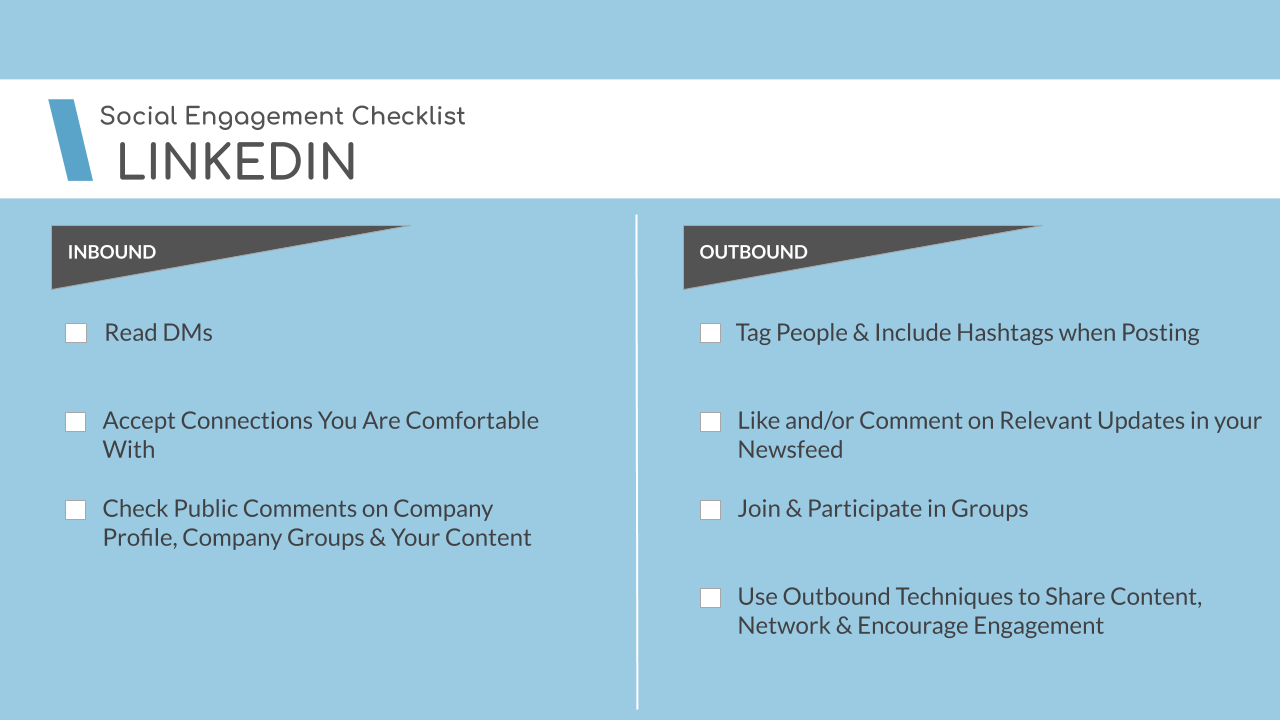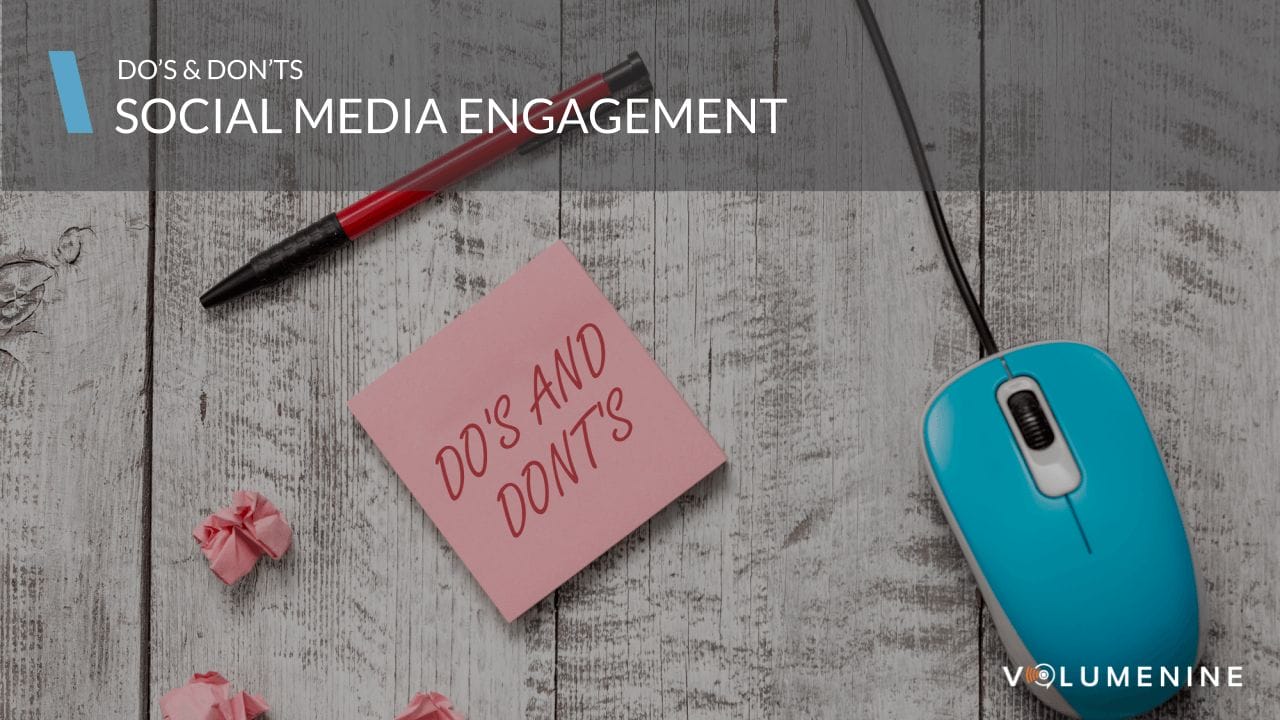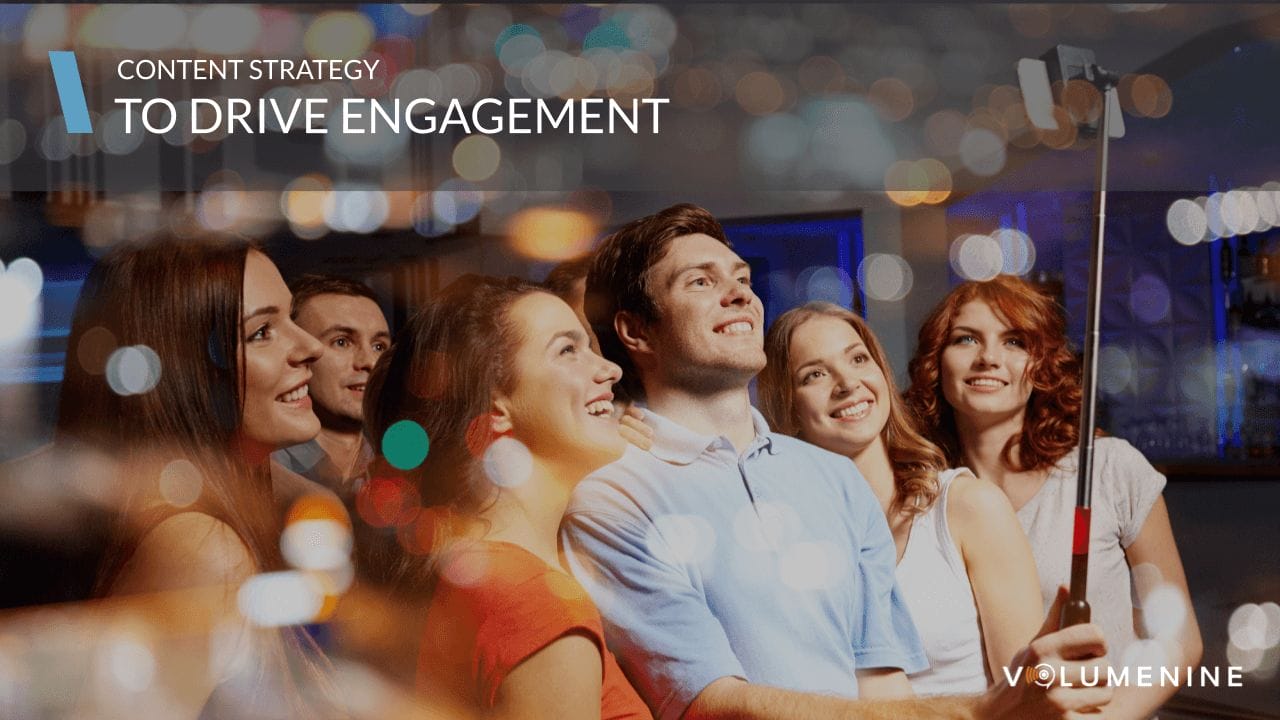Social Media Engagement Guide
Check out our comprehensive social media engagement guide that will skyrocket your engagement and ROI from social media.
Social Media Engagement Guide
Whether you are a startup with a small team or a social media manager for a large brand, social media engagement can seem like an overwhelming process to maintain. However, a well-thought-out plan can help you commit to your social media on a regular basis, allowing you to connect with your audience, build brand loyalty, and reach potential new customers.
Take a look at our checklist of social media activities below to start seeing more engagement (and results).
Don’t have a lot of time to read all of this? No problem – here’s a downloadable PDF with the social media checklists!
Also, worried your social strategy needs a revamp? Here’s a full guide on how to conduct a social media audit.
Giving credit: Compiling and condensing this information down was 100% a team effort. Special thanks to Rachel Newton, Carly Webber, Anastasia Briggs, Evan Kiesow & Miranda Ryder for pulling this together with me. – Natalie
Table of Contents
- Why Social Media Engagement Matters
- Guidelines For Social Media Communication
- Checklist Frequency (Daily, Bi-Weekly, Weekly)
- Official Social Media Engagement Checklist by Platform
- Bonus: Dos & Don’ts Policy For Your Team
- Let’s Talk about Content
- Setting Goals & KPIS for Social Media Engagement
- Boosting engagement and brand awareness with social media
Why Social Media Engagement Matters
Case study: CPG brand
About 3 years ago, we started working with a Consumer Package Goods ( CPG) brand (vitamins and supplements) that had a large retail presence across the US & Canada, and a large e-commerce store. They came to us because their results on social had largely stagnated. Their communities weren’t growing, their ads were delivering worse and worse returns, and their competitors were starting to eclipse them. When digging in, we realized this brand had a very self-promotional, one-way strategy they were running on social media (think BOGO ads). We helped them transition to more of a lifestyle brand and, as part of that, helped them promote and encourage a healthy lifestyle. This involved not only great content but also great engagement to really help them build an active community.
Not only did their communities grow exponentially in a 6-month time frame, but they also started to have successful ad campaigns again. The first ad campaign for this engaged community had a 14:1 ROAS — one of the most successful social campaigns they have ever run.
Read the full case study here.
A look at the industry overall
For brands who struggle with things like social media community growth, ROI on social media, and building a brand online, social media community engagement tends to be the missing link.
I’m sure it’s no shock that social media platform adoption continues to grow at a high rate. As of 2018, 72% of the public was using social media (source: Pew Internet & American Life Project). Although tracking the value of social media engagement can be really challenging using tools like Google Analytics, 64% of marketers also still said that increasing audience engagement was crucial for their social media marketing strategy (source: Invesp).
A major trend we at V9 have seen over the recent years is brands wanting to switch from a product-first message to a lifestyle-first message. As brands make this transition, the main tools they have to promote an authentic lifestyle message are great content and stellar engagement.
Guidelines For Social Media Communication
Check on your community regularly
Whether it’s related to a brand ambassador program, forum, Facebook group, or community website, it’s important to ensure everything is running smoothly. You need to make sure people are receiving the support they need, their questions are being answered, and they feel a sense of community. Remember, this isn’t just a social media platform — it’s really a social network.
Be authentic
You need to be authentic while managing and engaging with any type of community. When the customers, fans, followers, and leads come to your social media pages, they should immediately know it based on different factors like your branding and voice. And no matter the type of interaction, being genuine and human is crucial whether or not you’re behind a screen or face-to-face. After all, one of the main reasons you created a community is to make sure the members feel valued, right?
Listen
Since community management requires so much thoughtful interaction with members, listening is crucial. Whether it’s social listening, reviewing your forum and FAQ pages regularly, or responding to in-person and online feedback, listening is how you’ll improve your community to the best of your ability. It also shows your audience and members you value their opinions, hear what they have to say, and care about their experiences within your community. It can also help to inform and drive content strategies based on common, relevant topics your customers and community care about.
Show appreciation
A large part of managing a successful community is showing appreciation for its members. This will help you build brand loyalty and trust between you and the members. It also shows your members how much you value their time and commitment to the brand — remember, some of those community members are also likely to be some of your most invested, supportive, and loyal fans, followers, and customers already.
To ensure you’re showing appreciation when necessary, you can try the following tactics depending on the type of community you have:
- Interact with new community members as soon as they join — say, “Thank you and welcome!” and ask them what you can do to make their experience a great one.
- Pay attention to who your biggest community contributors are (keep a document with their names, emails, etc.). This way you give them a shout-out for simply being awesome.
- Keep an eye out for mentions, keywords, and hashtags, on your social media platforms so you’re able to engage with those people to show your appreciation and the human element behind the community.
Maintain your brand voice at all times
Maintaining your brand’s voice at all times is critical when it comes to community management. This is a large part of what makes your community unique and is what ensures your community is identifiable to your members and audience.
No matter how many people are working on your community, make sure they understand your brand voice so they can help you maintain it throughout all interactions, engagement, and content.
Explore new ways to engage your community
You always want to be engaging your community — but what happens if there are changes in the industry, the company’s products or services are drastically updated, or your members request new types of content?
To keep your community up to date, always explore new ways to engage your members. You can also engage members as soon as they join to continue learning about your audience, what they want from you, and what made them join your community — this will also help you learn about new ways to interact with them.
At this point, you may be wondering how to get all of this work started — but don’t worry! We’ve put together a great checklist below to help get you started.
Checklist Frequency (Daily, Bi-Weekly, Weekly)
How often should you be following the checklist? Daily? Weekly? Monthly? The reality is that, even though it would be great to do all of these things daily, that isn’t realistic for most brands.
To help our clients work through what frequency works best for them, we like to divide the checklists into two major lists — inbound and outbound social media.
Inbound Social Media Engagement
Definition: Responding to comments and messages that have come into your brand on social media. A good example is responding to a DM on Facebook. Generally, you’ll deal with positive interaction as well as customer complaints or concerns with inbound engagement.
Ideal frequency: This type of engagement is the most important to commit to on a higher frequency, as this is your audience actively speaking to you. This is something you should be monitored daily for a few minutes.
Outbound Social Media Engagement
Definition: Actively going out and finding conversations and engagement opportunities on social media. An example is following and jumping into a hashtag conversation. This kind of social engagement is more optional and can be taken on if you have the resources, as opposed to inbound social engagement, which is necessary for your brand’s reputation.
Ideal frequency: The great part about these types of activities is that you can set aside time and plan to do them. For brands looking to commit to having an engaging social media brand, you should be setting aside 2-3 times per week for these types of activities.
Official Social Media Engagement Checklist by Platform
Checklist For Facebook Engagement
It’s no surprise that 97% of social advertisers choose Facebook as their most-used platform (source: Sprout Social). Considering the wide public adoption of the platform coupled with the targeting available to advertisers, if you are developing a social engagement strategy it will most likely have to include Facebook.
Inbound Facebook – Social Media Tasks
- Read all incoming direct messages to your Facebook page daily, every other day, or weekly (depending on the volume of messages received)
- Flag or ignore spam or inappropriate messages\
- Respond to customer service issues or forward them along as soon as possible
- Thank customers who send positive or friendly messages
- Reply to common questions or issues in messages with previously written, appropriate responses
- Check all public comments on your Facebook page daily, every other day, or weekly (depending on the volume of comments received)
- Like, react, and reply to positive comments with an on-brand voice; e.g. “Glad you liked our product!” or “So happy we could help you out!”
- Reply to posted questions with correct information and links to your site, if appropriate
- Hide negative comments or complaints
- Immediately follow up with a direct message to the poster
- Hide or delete spam or inappropriate comments
Outbound Facebook – Social Media Tasks
- Invite users who have liked content to follow the page
- Develop a list of friendly brands (e.g. a vendor you work with) and engage with their content
- Pro tip: Create a list of five to six branded posts that are approved for generic engagement
- Utilize Facebook’s search function to look up relevant keywords, events, or locations to engage with trending topics in real-time.
- Use audience insights to understand your followers and target potential users similar to existing customers with ads
Checklist for Instagram Engagement
Because Instagram is a heavily visual social media platform, you’ll be creating and engaging with a lot of photos and videos. Like Facebook, you’ll need to stay on top of customer service issues, but don’t forget to pay attention to positive comments, tagged posts, and (especially) Instagram Stories.
Inbound Instagram – Social Media Tasks
- Read all incoming direct messages to your Instagram account daily, every other day, or weekly (depending on the volume of messages received)
- Flag or ignore spam or inappropriate messages
- Respond to customer service issues or forward them along as soon as possible
- Thank customers who send positive or friendly messages
- Reply to common questions or issues in messages with previously written, appropriate responses
- Check all comments daily, every other day, or weekly (depending on the volume of comments received)
- Reply to positive comments with an on-brand voice; e.g. “Glad you liked our product!” or “So happy we could help you out!”
- Like other comments
- Reply to posted questions with correct information
- Reply to negative comments or complaints letting the customer know that you’ve sent them a direct message
- Immediately follow up with a direct message to the poster
- Flag or delete spam or inappropriate comments
- Monitor tagged or mentioned user content.
- Ask for permission to re-gram and remember to give credit.
- Curating user-generated content (UGC) is a great way to interact with customers: you build your own content and they receive recognition for using your product or service
Outbound Instagram – Social Media Tasks
- If your brand has created company-specific hashtags or uses existing hashtags, look at posts and stories under those hashtags
- Look at competitors’ Instagram accounts to see what’s working and what’s not
- Follow and engage with influencers in your industry
- Follow and engage with users in your target audience
- For example, if you find yourself promoting certain users often, be sure to follow, like, and comment on their content
Checklist for Twitter Engagement
Utilizing Twitter for your brand might not make sense for every company, and not everyone can be Wendy’s. However, it’s pretty clear that if you want your Twitter channel to be a game-changer, top-notch engagement with a consistent brand personality is how you accomplish that. To get inspired, here’s a list of the brands that are doing the best with Twitter.
Inbound Twitter – Social Media Tasks
- Read all incoming direct messages to your Twitter account daily, every other day, or weekly (depending on the volume of messages received)
- Flag or ignore spam or inappropriate messages
- Respond to customer service issues or forward them along as soon as possible
- Thank customers who send positive or friendly messages
- Reply to common questions or issues in messages with previously written, appropriate responses
- Ignore standard “Thank you for following” messages
- Check @mentions daily, every other day, or weekly (depending on the volume of mentions received)
- Like or reply to positive tweets or retweets with an on-brand voice; e.g. “Glad you liked our product!” or “So happy we could help you out!”
- Reply to posted questions in tweets with correct information
- Reply to negative tweets or complaints letting the customer know that you’ve sent them a direct message
- Immediately follow up with a direct message to the poster
- Flag or delete spam or inappropriate tweets
Outbound Twitter – Social Media Tasks
- Retweet relevant posts from other accounts
- @mention partners or complementary brands, new followers, or friendly members of your target audience
- Follow and engage with users in your target audience
- Follow related hashtags and participate in conversations when appropriate
Checklist for LinkedIn Engagement
For B2Bs or any brand targeting professional audiences, having a strong LinkedIn program can be a huge way to drive awareness and leads. The trick with LinkedIn is that what the “brand” page can do is limited, and the personal profiles for your key stakeholders should also be a big part of the plan. Many brands publish thought leadership and invest in outbound LinkedIn programs with tools like LinkedIn Navigator, but they stop short by not having a strong engagement strategy to back those initiatives.
Inbound LinkedIn – Social Media Tasks
- Read all incoming direct messages to your Company Profile daily, every other day, or weekly (depending on the volume of messages received)
- Flag or ignore spam or inappropriate messages
- For the next steps in hiring or sales inquiries, reply with the appropriate information or next steps
- Thank customers who send positive messages
- Reply to questions or issues in messages with friendliness and respect
- Customer service issues are rarer on LinkedIn, but be sure to respond and/or forward them along as soon as possible
- Accept connections as you feel comfortable
- If they’re located in your city, in your industry, or in your target audience, they’ll likely make a good addition to your network
- Check all public comments on your Company Profile daily, every other day, or weekly (depending on the volume of comments received)
- Reply to positive comments with an on-brand voice; e.g. “Glad you liked our product!” or “Happy we could help you out!”
- Reply to posted questions with correct information and links to your site, if appropriate
- Hide negative comments or complaints
- Immediately follow up with a direct message to the poster
- Hide or delete spam or inappropriate comments
Outbound LinkedIn – Social Media Tasks
- Tag people and include hashtags when posting
- Like and/or comment on relevant updates in your newsfeed
- Join relevant industry groups and regularly like, react, and comment on relevant posts
- Word of caution: on more contentious threads, always weigh your brand guidelines over your personal opinions.
- If LinkedIn prospecting is a large part of your business, consider tools like LinkedIn Navigator or messaging services to incorporate into your outbound mix.
- Consider making these types of reach-outs an extension of your networking and brand engagement instead of direct response tools. For example, share content instead of asking someone to buy your product or service on an initial reachout.
Bonus: Dos & Don’ts Policy For Your Team
Are you planning to have other team members help with your social media engagement efforts? If so, we have found it’s hugely valuable to get everyone on the same page… literally. One of the things we always put together on an engagement project is a list of the “Dos and Don’ts” that we want the team to follow. To help you draft this up for your team, these are some of the standard ones we start with:
DO:
- Engage in positive comments
- Educate customers about the brand and products
- Extend conversations if you can — either with questions or calls to action
- Jump into relevant trending conversations
- Provide links to relevant website pages in conversations
- Remain true to brand core values in every engagement
- Always respond to product questions by including links to the specific item
- Hide negative comments and send a DM
- Stay empathetic and positive and offer solutions
- Hide or delete distasteful comments and spam
- Always try to take negative or personal conversations offline
DON’T:
- Mention competitors or respond to comments that mention competitors
- Mention the brand in photos of celebrities or UGC without written permission
- Engage with controversial, political, or harassing comments
- Use profanity, argumentative, or negative language
- Make promises or guarantees
- Engage in an argument with a consumer
- Apologize for issues without written permission from leadership
- Acknowledge or share comments that include profanity (even if the comment is positive)
- Use slang or acronyms
- Use excessive or inappropriate emojis
- Go off-brand
- Collect personal info from users publically
- Disclose confidential information
Let’s Talk about Content
Great engagement is only one key part of a social media strategy. However, it’s virtually impossible to have great social media engagement if you’ve got lousy content.
To create awesome and engaging social media content:
- Step 1: Start by setting your KPIs, so that everyone is on the same page about what success looks like.
- Step 2: Understand and document your target persona and the tribe/lifestyle you are looking to facilitate. This will help you develop social media posts that are relevant to your target audience.
- Step 3: Create a social media calendar that is 80% + lifestyle/engagement-focused and 20% or less product-focused. We recommend using tools like Sprout Social & HeyOrca that allow for multiple revision rounds before a calendar is scheduled.
- Step 4: Test and utilize different visual content formats (images, gifs, videos, etc). A good rule of thumb? When in doubt, make a video. They get 21.2% more interactions compared to images and 18.6% more interactions compared to carousels. (source: Sprout Social)
- Step 5: Put money behind content that seems to resonate more. If you have a gif that is getting higher engagement rates than any of your other content, it’s worth it to put a few bucks behind it to provide more momentum.
- Step 6: Test, measure, and adjust every month and absolutely every quarter. Setting your goals and KPIs and keeping track of how your content is affecting those metrics is critical to steady growth and success.
Setting Goals & KPIs for Social Media Engagement
Setting Goals and KPIs (Key Performance Indicators) for social media engagement can be really challenging, especially when trying to measure this in the broader context of your social or digital marketing strategies. In general, some of the best metrics to measure whether you are being more engaged in your content are:
- Follower growth
- Shares
- Comments
- Likes
- Reactions
- DMs
- Email signups
- Purchases and clicks from ads
- Shares, positive reviews, @mentions
To help you think through and set social media KPIs that make the most sense for your brand, here’s a helpful chart that maps business objectives, social media goals, and metrics together:
Boosting engagement and brand awareness with social media
Our hope here at V9 is to give you the tools you need to make the most of your social media marketing. To see more engagement on social, you have to be genuine, maintain your brand voice, be responsive, and explore new or different ways to engage your community. If you want to see even more results from your social media marketing, V9 can help. We’re a digital marketing agency that has helped a multitude of beauty, outdoor, and health brands transition to a lifestyle marketing strategy — so they can finally see real results with their social media efforts.

